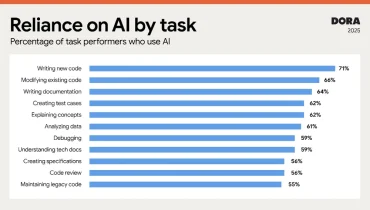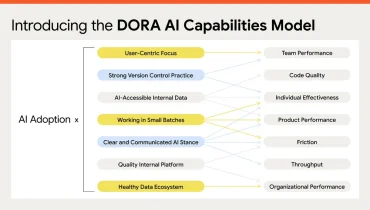
- AI
- Developer Tools
- Platform Engineering
Google DORA Report: AI Usage Surges to 90% Among Developers
5 minute read

Platform engineering and developer AI tools reshape software teams as adoption reaches 90% across tech industry
Key Takeaways
- AI adoption reaches 90% among developers as Google’s DORA report reveals a 14% year-over-year increase, with median usage at two hours daily across software development teams.
- Performance amplification creates divergent outcomes as AI strengthens high-performing teams while exposing dysfunction in weaker organizations, with only 59% reporting improved code quality despite widespread adoption.
- Platform engineering emerges as critical success factor with 90% of organizations now running internal platforms, directly correlating with teams’ ability to extract value from AI tools effectively.
Introduction
AI technology has become the foundation of modern software development, but its impact varies dramatically based on organizational strength. Google Cloud’s 2025 DORA report surveyed over 5,000 software professionals and reveals that 90% of technology workers now use AI daily, marking a 14% increase from 2024.
The research exposes a critical paradox: AI functions as an organizational amplifier, enhancing efficient teams while exacerbating problems in dysfunctional ones. This dynamic carries significant implications for business strategy, development costs, and competitive positioning across the technology sector.
Key Developments
The DORA survey participants included product managers, site reliability engineers, and security professionals, with over 100 hours of interview data supporting the quantitative findings. Median AI usage reaches two hours per day, with two-thirds of developers relying on AI for at least half their workflow.
Despite widespread adoption, trust remains measured. Only 25% of respondents trust AI outputs “a lot” or “a great deal,” while 30% express minimal confidence. This trust paradox reflects how developers treat AI as a productivity accelerator rather than an autonomous coding solution.
The research identifies seven distinct team archetypes influencing AI integration success. “Harmonious High-Achievers” represent 20% of teams, balancing throughput and stability with low burnout. Conversely, teams facing “Foundational Challenges” comprise 10% of organizations, where process gaps and high burnout undermine AI’s potential benefits.

Market Impact
AI adoption creates measurable business outcomes across development organizations. Strong teams experience reduced time-to-market and lower development costs, improving margins through faster product iteration. These teams leverage AI to accelerate delivery and enhance product performance.
Weaker teams face increased technical debt and system instability as AI-driven acceleration exposes architectural flaws. Key failure modes include logic duplication between services, dependency-level divergence, and brittle testing frameworks that cannot support accelerated development cycles.
The productivity gains show mixed results across the industry. While 49% of developers report “somewhat” trusting AI-generated output, only 31% see slight code improvements, and 30% report no impact on code quality.
Strategic Insights
Platform engineering investments emerge as the primary differentiator for AI success. Organizations with high-quality internal platforms demonstrate superior ability to extract value from AI tools, while those lacking robust infrastructure struggle with implementation.
Value Stream Management (VSM) becomes essential for balancing AI-driven acceleration with business priorities. By visualizing work processes, VSM helps identify productivity bottlenecks and ensures AI initiatives align with strategic objectives rather than pursuing raw throughput.
The shift toward data-centric development reshapes required skillsets. As AI automates routine tasks like code generation and bug detection, developers focus increasingly on data curation, model management, and human-AI collaboration patterns.

Expert Opinions and Data
Nathen Harvey, DORA lead and developer advocate at Google Cloud, emphasizes that “the focus is on helping teams get the most out of AI.” He advocates prioritizing platform engineering initiatives to realize AI’s full potential across development organizations.
The DORA AI Capabilities Model outlines seven critical practices separating successful implementations from struggling teams. These include maintaining healthy data ecosystems, implementing strong version control practices, and developing user-centric product strategies that guide AI integration efforts.
According to Dora, the research corroborates external evidence from GitHub and Microsoft Research showing faster task completion with AI support. McKinsey identifies significant time savings on repetitive developer tasks through AI automation.
Industry leaders highlight the transformative potential while warning against over-reliance. The practical implications suggest AI can serve as either a compounding advantage or amplify organizational weaknesses, depending on internal platform maturity and engineering practices.
Conclusion
AI integration in software development has moved beyond experimental adoption to become baseline infrastructure for competitive organizations. The technology’s effectiveness depends entirely on underlying organizational systems and engineering practices rather than tool selection alone.
The research establishes that successful AI implementation requires investment in platform engineering, clear development processes, and user-focused strategies. Organizations meeting these requirements transform AI from operational risk into a powerful business accelerator, while those lacking foundational strength face amplified dysfunction and technical debt.







